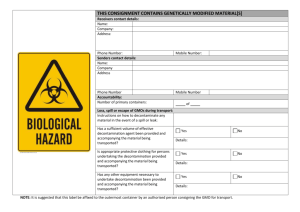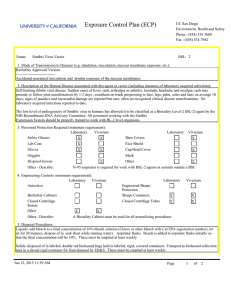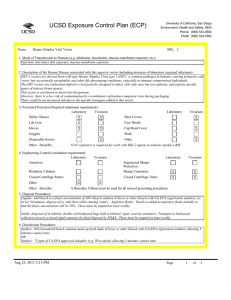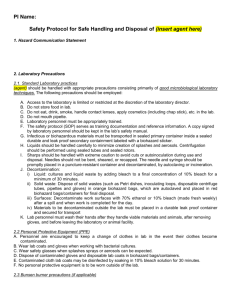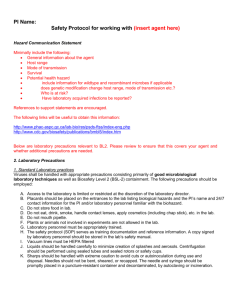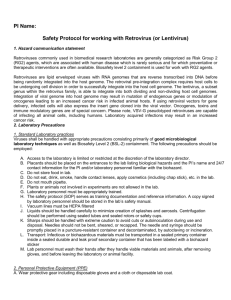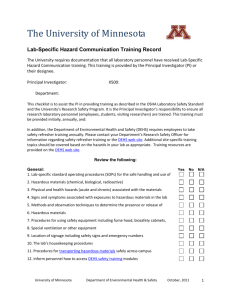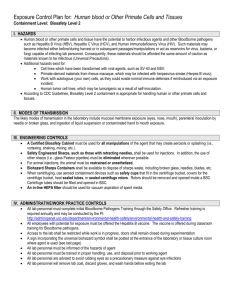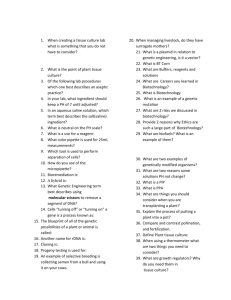Sample Biological Material Standard Operating Procedure
advertisement
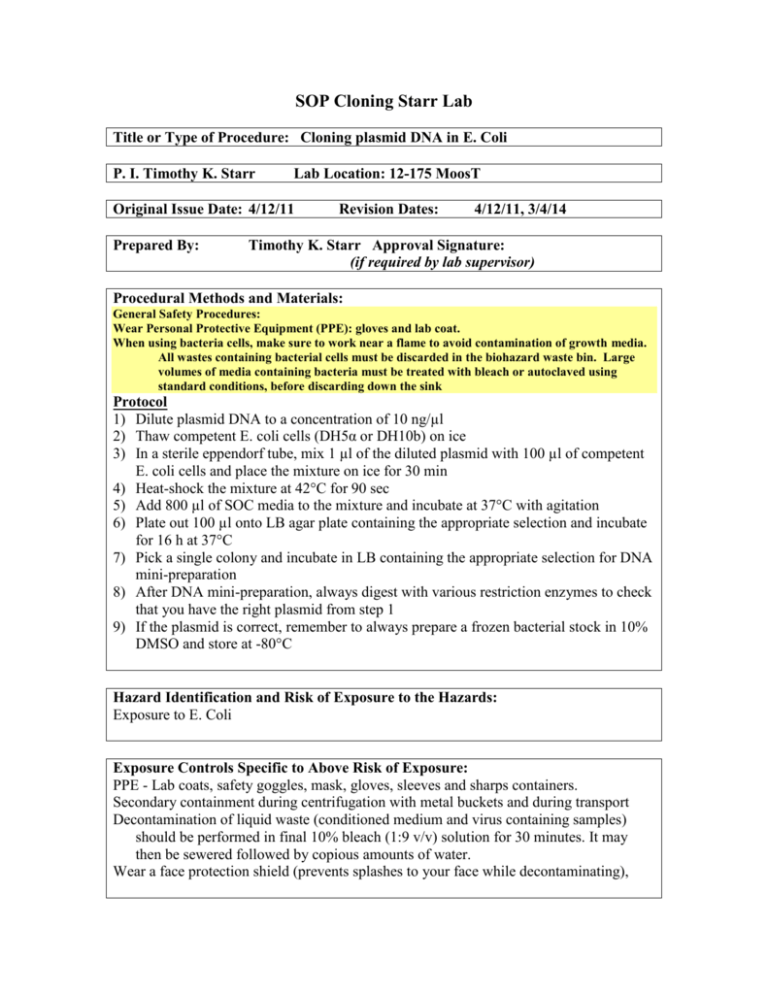
SOP Cloning Starr Lab Title or Type of Procedure: Cloning plasmid DNA in E. Coli P. I. Timothy K. Starr Lab Location: 12-175 MoosT Original Issue Date: 4/12/11 Prepared By: Revision Dates: 4/12/11, 3/4/14 Timothy K. Starr Approval Signature: (if required by lab supervisor) Procedural Methods and Materials: General Safety Procedures: Wear Personal Protective Equipment (PPE): gloves and lab coat. When using bacteria cells, make sure to work near a flame to avoid contamination of growth media. All wastes containing bacterial cells must be discarded in the biohazard waste bin. Large volumes of media containing bacteria must be treated with bleach or autoclaved using standard conditions, before discarding down the sink Protocol 1) Dilute plasmid DNA to a concentration of 10 ng/µl 2) Thaw competent E. coli cells (DH5α or DH10b) on ice 3) In a sterile eppendorf tube, mix 1 µl of the diluted plasmid with 100 µl of competent E. coli cells and place the mixture on ice for 30 min 4) Heat-shock the mixture at 42°C for 90 sec 5) Add 800 µl of SOC media to the mixture and incubate at 37°C with agitation 6) Plate out 100 µl onto LB agar plate containing the appropriate selection and incubate for 16 h at 37°C 7) Pick a single colony and incubate in LB containing the appropriate selection for DNA mini-preparation 8) After DNA mini-preparation, always digest with various restriction enzymes to check that you have the right plasmid from step 1 9) If the plasmid is correct, remember to always prepare a frozen bacterial stock in 10% DMSO and store at -80°C Hazard Identification and Risk of Exposure to the Hazards: Exposure to E. Coli Exposure Controls Specific to Above Risk of Exposure: PPE - Lab coats, safety goggles, mask, gloves, sleeves and sharps containers. Secondary containment during centrifugation with metal buckets and during transport Decontamination of liquid waste (conditioned medium and virus containing samples) should be performed in final 10% bleach (1:9 v/v) solution for 30 minutes. It may then be sewered followed by copious amounts of water. Wear a face protection shield (prevents splashes to your face while decontaminating), Waste Generated and Disposal Methods: Liquid waste will be collected in a flask or beaker containing bleach 10% (v/v) and will soak for 30 minutes before being sewered. Solid waste decontamination Disposables will be placed in a biohazard bag and incinerated Refer to the Biological Waste Disposal procedures posted on the Tissue Culture room door for more information Spill Response Procedures: For spill, splash or aerosol clean up: In general, decontamination is done using bleach. Decontamination of liquid waste (conditioned medium and virus containing samples) should be performed in final 10% bleach (1:9 v/v) solution for 30 minutes. It may then be sewered followed by copious amounts of water. Decontaminating a small volume spill, large volume spill and any splashes Wear a face protection shield (prevents splashes to your face while decontaminating), Cover the spill with paper towel and gently pour on top 10% bleach (1:9 v/v) solution for 30 minutes, followed by a rinse with water to remove remaining bleach that may pit or etch work surfaces & equipment if needed, then followed by a 70% ethanol rinse Collect the paper towels to the biohazard bag. Refer to the Biological Decontamination and Spill Clean-up Plan posted on the Tissue culture room door for more information Accident Response Procedures: If Incident Results in a Hazard Exposure ( i.e. face or eye splash, cut or puncture with sharps, contact with non-intact skin): • Encourage needle sticks and cuts to bleed, gently wash with soap and water for 5 minutes; flush splashes to the nose, mouth, or skin with water; and flush eyes at the nearest eyewash station with clean water for 15 minutes. • Call 911 or seek medical attention. For urgent care employees may go to HealthPartners Occupational and Environmental Medicine (M/F day time or Urgent Care after hours), or UMMC-Fairview Hospital (24 hrs). You may seek medical attention at the closest available medical facility or your own healthcare provider. Follow-up must be done by HealthPartners Occupational and Environmental Medicine. • Report the incident to your supervisor as soon as possible, fill out the appropriate documentation. Employee First Report of Injury Supervisor Incident Investigation Report • Send Incident Report Form to the IBC if exposure has occurred during work on an IBC protocol. • Report all biohazard exposures to the Office of Occupational Health and Safety (612-626-5008) or uohs@umn.edu. Note: It is important to fill out all of the appropriate documents to be eligible to collect workers compensation should any complications from the hazardous exposure arise in the future. Notes: References: For further information view the UMN DEHS website containing Bio Basic Fact Sheets at http://www.dehs.umn.edu/bio_basicfacts.htm. For general information on Biosafety, access the Biosafety in Microbiological and Biomedical Laboratories (BMBL) 5th Edition from the CDC at BMBL http://www.cdc.gov/biosafety/publications/bmbl5/index.htm For Material Safety Data Sheets access the Public Health agency of Canada website MSDS http://www.phac-aspc.gc.ca/lab-bio/res/psds-ftss/index-eng.php.
